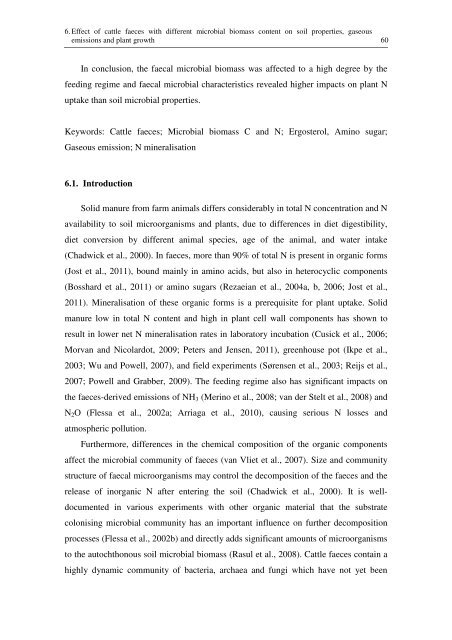Fütterungsbedingte mikrobielle Zusammensetzung von Rinderkot ...
Fütterungsbedingte mikrobielle Zusammensetzung von Rinderkot ...
Fütterungsbedingte mikrobielle Zusammensetzung von Rinderkot ...
Create successful ePaper yourself
Turn your PDF publications into a flip-book with our unique Google optimized e-Paper software.
6. Effect of cattle faeces with different microbial biomass content on soil properties, gaseous<br />
emissions and plant growth 60<br />
In conclusion, the faecal microbial biomass was affected to a high degree by the<br />
feeding regime and faecal microbial characteristics revealed higher impacts on plant N<br />
uptake than soil microbial properties.<br />
Keywords: Cattle faeces; Microbial biomass C and N; Ergosterol, Amino sugar;<br />
Gaseous emission; N mineralisation<br />
6.1. Introduction<br />
Solid manure from farm animals differs considerably in total N concentration and N<br />
availability to soil microorganisms and plants, due to differences in diet digestibility,<br />
diet conversion by different animal species, age of the animal, and water intake<br />
(Chadwick et al., 2000). In faeces, more than 90% of total N is present in organic forms<br />
(Jost et al., 2011), bound mainly in amino acids, but also in heterocyclic components<br />
(Bosshard et al., 2011) or amino sugars (Rezaeian et al., 2004a, b, 2006; Jost et al.,<br />
2011). Mineralisation of these organic forms is a prerequisite for plant uptake. Solid<br />
manure low in total N content and high in plant cell wall components has shown to<br />
result in lower net N mineralisation rates in laboratory incubation (Cusick et al., 2006;<br />
Morvan and Nicolardot, 2009; Peters and Jensen, 2011), greenhouse pot (Ikpe et al.,<br />
2003; Wu and Powell, 2007), and field experiments (Sørensen et al., 2003; Reijs et al.,<br />
2007; Powell and Grabber, 2009). The feeding regime also has significant impacts on<br />
the faeces-derived emissions of NH3 (Merino et al., 2008; van der Stelt et al., 2008) and<br />
N2O (Flessa et al., 2002a; Arriaga et al., 2010), causing serious N losses and<br />
atmospheric pollution.<br />
Furthermore, differences in the chemical composition of the organic components<br />
affect the microbial community of faeces (van Vliet et al., 2007). Size and community<br />
structure of faecal microorganisms may control the decomposition of the faeces and the<br />
release of inorganic N after entering the soil (Chadwick et al., 2000). It is well-<br />
documented in various experiments with other organic material that the substrate<br />
colonising microbial community has an important influence on further decomposition<br />
processes (Flessa et al., 2002b) and directly adds significant amounts of microorganisms<br />
to the autochthonous soil microbial biomass (Rasul et al., 2008). Cattle faeces contain a<br />
highly dynamic community of bacteria, archaea and fungi which have not yet been
















